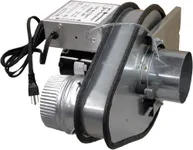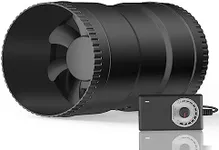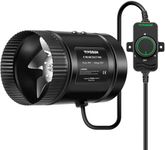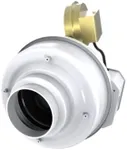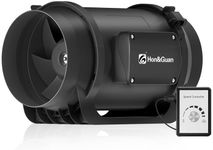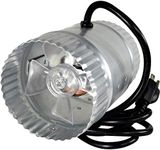Buying Guide for the Best Dryer Vent Boosters
Choosing a dryer vent booster is all about ensuring your dryer works efficiently and safely, especially if your venting system is long or has several bends. A booster helps move air and lint through the vent, reducing the risk of clogs and improving drying times. When picking the right one, you should focus on how well it fits your vent setup, how easy it is to maintain, and how it operates with your dryer. Understanding the key specifications will help you make a choice that matches your home's needs and keeps your laundry routine running smoothly.Airflow Capacity (CFM)Airflow capacity, measured in cubic feet per minute (CFM), tells you how much air the booster can move through your vent. This is important because a higher CFM means the booster can handle longer or more complex vent runs, helping to prevent lint buildup and improve drying efficiency. Generally, lower CFM (around 100-150) is suitable for shorter, straighter vents, while higher CFM (over 200) is better for longer or more complicated vent paths. To pick the right one, consider the length and number of bends in your vent; the more distance and turns, the higher the CFM you’ll need.
Activation MethodThe activation method describes how the booster fan turns on and off. Some boosters use a pressure or current sensor to detect when the dryer is running, while others may require manual operation or a timer. Automatic activation is more convenient and ensures the booster only runs when needed, which is ideal for most users. Manual options might be suitable if you want more control, but they require you to remember to turn the booster on and off. Think about your preference for convenience and how hands-on you want to be when choosing this feature.
Noise LevelNoise level refers to how loud the booster fan is when operating. This matters if your laundry area is close to living spaces or bedrooms, as a noisy fan can be disruptive. Noise is usually measured in decibels (dB), with lower numbers being quieter. Quiet models are typically under 50 dB, while louder ones can be 60 dB or more. If you value a peaceful home environment, look for a booster with a lower noise rating.
Duct CompatibilityDuct compatibility means the size and type of vent the booster can connect to. Most residential dryers use 4-inch ducts, but it’s important to check that the booster matches your existing vent size and material. Some boosters are designed for flexible ducts, while others work best with rigid metal ducts. Make sure the booster you choose fits your vent system to ensure proper installation and performance.
Maintenance RequirementsMaintenance requirements refer to how often and how easily you need to clean or service the booster. Since lint can build up in the fan, regular cleaning is important for safety and efficiency. Some boosters have easy-access panels or removable parts to make cleaning simpler, while others may require more effort. If you prefer low-maintenance options, look for boosters designed for easy cleaning and check how often the manufacturer recommends maintenance.
Safety FeaturesSafety features include things like thermal protection, which shuts off the booster if it overheats, and alarms or indicators for blockages. These features help prevent fires and alert you to problems before they become serious. If safety is a top concern, look for boosters with built-in protection and clear indicators so you can address issues quickly.


